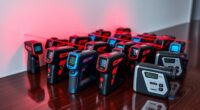If you’re choosing between infrared and RF systems for theaters, consider their strengths and weaknesses. Infrared offers reliable audio quality with less interference but requires a clear line of sight and is limited in range, making it ideal for small, controlled spaces. RF systems cover larger areas, allow greater mobility, but are more prone to interference and higher costs. To get a full understanding of which suits your venue best, explore more about their operational differences.
Key Takeaways
- Infrared systems offer high sound fidelity with minimal interference but require direct line-of-sight, limiting movement and coverage.
- RF systems provide larger coverage and obstacle penetration, ideal for big theaters, but are more susceptible to wireless interference.
- Infrared setups are simpler, cheaper, and easier to maintain, making them suitable for smaller, controlled environments.
- RF systems enable greater mobility for performers and staff but involve complex installation, higher costs, and potential licensing issues.
- Overall, infrared is better for aesthetic and straightforward venues, while RF suits large, dynamic spaces needing extensive coverage.
Understanding Infrared and RF Technology

Infrared and RF (radio frequency) systems are both essential for wireless communication and tracking in theaters, but they operate using fundamentally different technologies. Infrared systems use light signals directed from transmitters to receivers, requiring a clear line of sight and limiting interference. Infrared safety is a key consideration, as bright IR signals must not harm users’ eyes or cause discomfort. RF systems transmit signals via radio waves, which can pass through obstacles and cover larger areas without direct line of sight. However, RF licensing is often necessary to operate these systems legally, depending on the frequency used. While RF offers greater flexibility, it can also be more prone to interference. Understanding these technological differences helps you choose the right system for your theater’s safety and operational needs. Additionally, staying informed about emerging threats and security technologies can help ensure reliable and secure wireless communication.
Audio Quality and Clarity
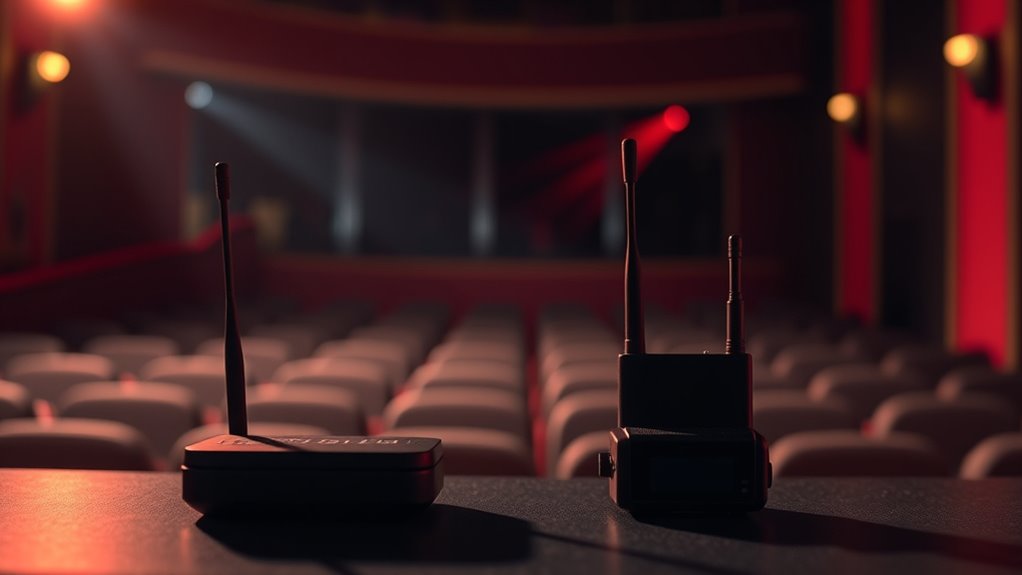
Signal interference can affect your audio clarity, especially with RF systems where other devices might cause disruptions. Infrared systems generally offer more consistent sound fidelity since they’re less prone to interference. Understanding these differences helps you choose the best system for clear, reliable sound in theaters. Additionally, advancements in sound design techniques and tools have improved the overall quality and immersion of audio experiences in modern theaters.
Signal Interference Risks
While both infrared and RF systems aim to deliver clear audio in theater environments, they each face distinct interference risks that can compromise sound quality. RF systems are susceptible to signal interference from other wireless devices, causing audio dropouts. Signal encryption and frequency hopping can help reduce these risks but aren’t foolproof. Infrared systems are less prone to RF interference but can be disrupted by physical obstructions or bright lights. Additionally, the refresh rates of projectors can influence how well these systems work in dynamic lighting conditions.
Sound Fidelity Consistency
Both infrared and RF systems endeavor to deliver consistent audio quality, but their ability to maintain sound fidelity can vary markedly in real-world settings. In an echo chamber, reflections can distort sound, making clarity harder to achieve. RF systems often struggle with interference, which can lead to fluctuations in audio quality, disrupting audience engagement. Infrared systems typically provide more stable sound, but their performance can be compromised by physical obstructions or bright lights, affecting fidelity. Inconsistent sound quality can cause distraction, reducing the immersive experience for your audience. To guarantee clear, reliable audio, consider the environment and choose the system that best minimizes echo and interference, so your audience stays engaged with crisp, accurate sound. Additionally, understanding vibrational energy and environmental factors can help optimize audio system performance and overall sound fidelity.
Interference and Signal Reliability

You’ll want to contemplate how obstructions can affect your system’s performance, as some signals may get blocked easily. Signal interference risks can also cause disruptions during performances, impacting reliability. Understanding these factors helps you choose a system that maintains clear, consistent audio for your audience. Additionally, considering signal propagation can help you select a setup that minimizes dead zones and ensures seamless coverage throughout the venue.
Susceptibility to Obstructions
Infrared and RF systems each face unique challenges when it comes to obstructions that can disrupt signal transmission. Infrared systems rely heavily on a direct line of sight, so even a small visual obstruction, like a person’s head or a piece of scenery, can block the signal. This makes them more vulnerable to interruptions caused by movement or set changes. RF systems, on the other hand, are less affected by visual obstructions because their signals can pass through walls and objects. However, large metal structures or dense materials can weaken or reflect RF signals, causing inconsistencies. In a theater environment, understanding these susceptibility differences helps you choose the right system to ensure reliable audio transmission without interruptions from visual obstructions. Additionally, maintaining optimal mental clarity among technicians and performers can improve communication and minimize accidental obstructions during performances.
Signal Interference Risks
While infrared systems depend on a direct line of sight and RF systems can navigate around obstacles, both are vulnerable to signal interference that can compromise audio quality. Environmental factors like strong sunlight, fluorescent lights, or other ambient lighting can disrupt infrared signals, causing dropouts or static. RF systems, on the other hand, are susceptible to electromagnetic interference from devices such as wireless routers, microphones, or nearby electronics, which can distort or weaken the signal. These interferences increase the risk of audio disruptions during performances, affecting clarity and audience experience. To take into account the environmental setup and choose systems with robust interference resistance, theaters need to evaluate the surroundings. Proper planning and shielding can help ensure reliable, high-quality sound delivery regardless of potential interference sources. Additionally, understanding cybersecurity vulnerabilities associated with wireless systems can help in implementing measures to protect audio equipment from malicious interference or hacking attempts.
Range and Coverage Capabilities
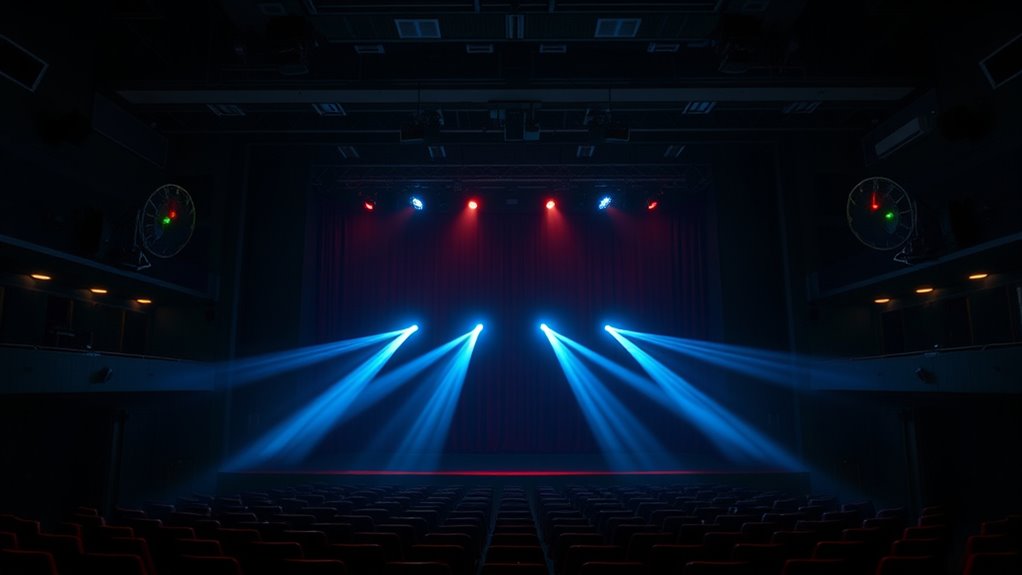
RF systems generally offer longer range and broader coverage compared to infrared systems. This means you can rely on RF to transmit audio signals over larger venues without losing quality or experiencing audio latency. Infrared systems, however, are more limited to smaller or enclosed spaces, which can impact user comfort if coverage isn’t consistent. To help visualize, consider this comparison:
| Feature | RF Systems | Infrared Systems |
|---|---|---|
| Range | Up to 100 meters | Up to 10 meters |
| Coverage | Wide, multi-room | Restricted, line-of-sight |
| Signal Stability | Less prone to interference | Sensitive to obstacles |
| Audio latency | Minimal, improves user comfort | Slight delay possible |
| Ideal for | Large venues | Small, controlled spaces |
This table highlights the advantages in range and coverage, affecting overall performance and user experience. Additionally, RF systems are often more cost-effective for large-scale applications.
Ease of Installation and Setup
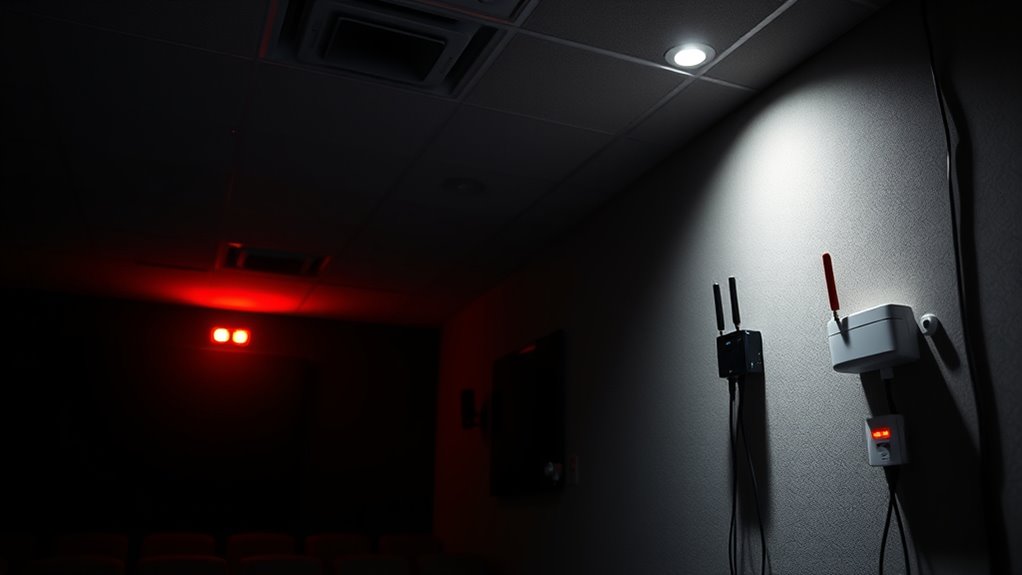
Installing and setting up wireless audio systems can vary considerably between infrared and RF technologies, affecting how quickly you can get your system operational. Infrared systems typically demand a more straightforward setup, with fewer components and less impact on venue aesthetics, making the installation process less complex. They usually require line-of-sight alignment, but this simplifies troubleshooting and reduces interference concerns. In contrast, RF systems often involve more complex installation steps, including configuring transmitters and receivers, managing frequency channels, and ensuring minimal interference, which can extend setup time. While RF systems might seem more involved initially, they tend to offer more flexibility for larger or more intricate venues. Additionally, understanding tuning Hyundai vehicles can provide insights into precise system adjustments for better performance. Overall, the choice impacts not only installation complexity but also how seamlessly you can integrate the system into your venue’s design.
User Experience and Mobility

Infrared systems often restrict user movement because they require a direct line of sight between the transmitter and receiver, which can limit mobility during use. This restriction impacts personal mobility, making it harder to move freely without losing signal. As a result, your user experience might feel confined, especially during dynamic activities. RF systems, on the other hand, offer greater flexibility since they don’t depend on line of sight, allowing you to move naturally around the theater. This enhances user comfort by providing a more seamless and less restrictive experience. With RF, you can shift positions or turn your head without worrying about losing signal, making the overall experience more enjoyable. Additionally, wireless technology in RF systems often results in easier setup and fewer obstructions, further supporting a more comfortable, mobile environment for theater attendees.
Cost and Maintenance Considerations
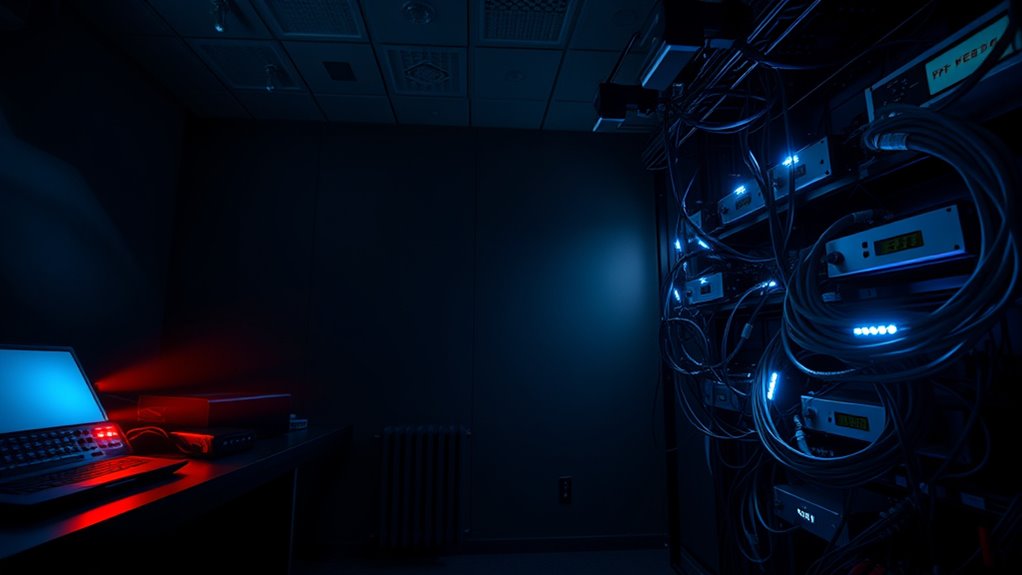
While both infrared and RF systems involve initial setup costs, RF systems generally require a higher upfront investment due to more advanced hardware. Your pricing strategies should consider these initial expenses and ongoing maintenance costs. RF systems tend to have:
- Higher maintenance costs because of complex components that may need frequent repairs or updates.
- More expensive hardware that may require specialized technicians for servicing.
- Greater reliance on licensing fees or spectrum management, adding to total costs over time.
Infrared systems usually have lower maintenance costs and simpler hardware, making them more budget-friendly in the long run. When evaluating costs, consider not only the initial investment but also how maintenance expenses and licensing fees impact your overall budget in the future.
Suitability for Different Theater Environments
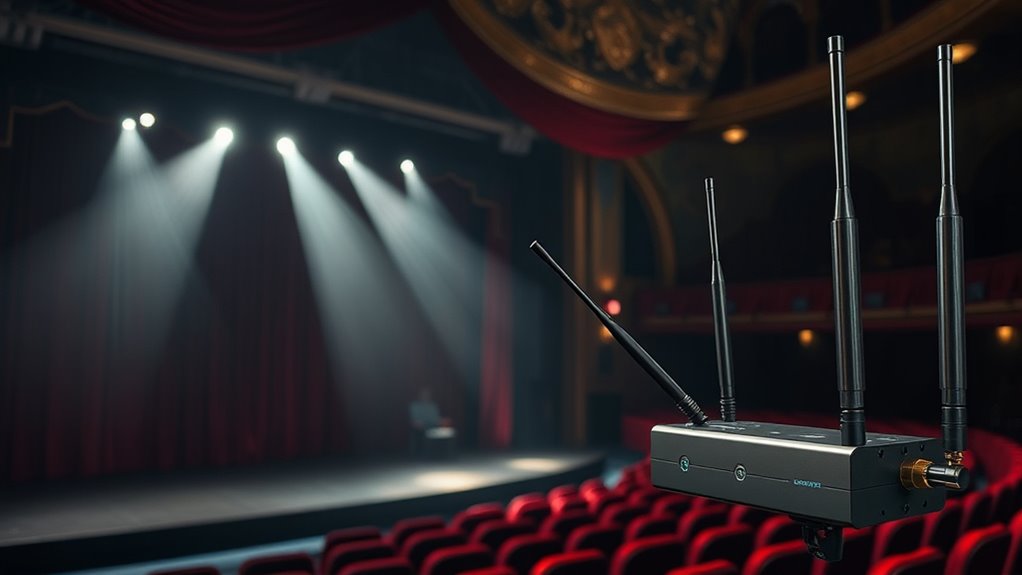
Choosing the right system depends heavily on the unique environment of your theater. If your audience favors clear, precise audio with minimal interference, infrared systems may be ideal, especially in smaller or well-controlled acoustic environments. They work well where line-of-sight is easy, and background interference is low. RF systems, on the other hand, excel in larger venues or spaces with challenging acoustics, as they can transmit signals through walls and obstacles without loss of quality. Consider your audience’s preferences for mobility and ease of use, since RF systems often support better movement without signal degradation. Ultimately, assess your theater’s size, layout, and acoustic conditions to determine which technology aligns best with your environment and audience needs.
Frequently Asked Questions
How Do Infrared and RF Systems Compare in Terms of Security?
You might wonder about the security of infrared and RF systems. Infrared signals are generally more secure because they’re confined to a physical line of sight, making unauthorized interception harder. RF systems, however, use encryption protocols to protect signals but can be vulnerable to signal interference and eavesdropping. So, while RF offers advanced encryption, infrared’s physical confinement provides a natural security advantage.
Are There Any Health Concerns Associated With Infrared or RF Transmission?
You might wonder if infrared or RF transmission poses health risks. Generally, both systems meet safety standards that limit exposure, reducing potential health concerns. Infrared radiation is non-ionizing and typically safe at operational levels, while RF systems are regulated to prevent harmful exposure. Still, it’s wise to follow safety standards and guidelines to guarantee your health remains protected, especially with prolonged or close contact.
What Are the Environmental Impacts of Deploying Infrared Versus RF Systems?
Imagine a world where your theater’s sound system quietly impacts the environment. Infrared systems typically use less energy and rely on sustainable materials, making them eco-friendlier. RF systems, while powerful, often consume more energy and involve materials that may be less sustainable. Your choice influences energy consumption and material sustainability, shaping a greener future. Think carefully about your environmental footprint when selecting the most suitable system for your needs.
Can These Systems Be Integrated With Existing Theater Audio Setups?
You can definitely integrate infrared or RF systems with your existing theater audio setups. Focus on system compatibility and technical integration to guarantee smooth operation. Check if the new wireless system supports your current audio equipment’s standards and interfaces. Sometimes, you may need adapters or additional equipment to bridge compatibility gaps. Proper planning and consultation with system providers help you achieve seamless integration, enhancing overall audio performance without disrupting your current setup.
How Do Maintenance Requirements Differ Between Infrared and RF Systems?
You’ll find that maintenance requirements differ between infrared and RF systems. Infrared systems typically have lower maintenance complexity and minimal calibration needs, making them easier to upkeep. RF systems, on the other hand, often require more frequent calibration and checks due to potential interference and signal stability issues. Staying on top of these maintenance needs ensures peak performance and reduces downtime, so choose based on your theater’s technical support capabilities.
Conclusion
Choosing between infrared and RF systems depends on your theater’s unique needs. As you weigh their strengths—clarity, coverage, ease of setup—you might find that the right system seamlessly enhances your audience’s experience, just as the perfect sound system becomes invisible yet indispensable. Sometimes, the best choice isn’t about technology alone but about how it aligns with your space and your audience’s comfort, turning every show into a memorable experience.


